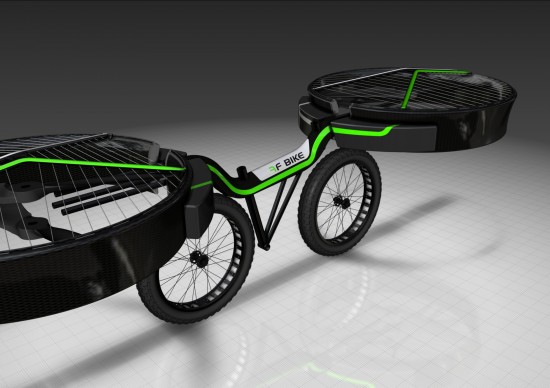Welcome to our web
When growing up, most of us had dreams and ideas that originated in reading books and watching films.
The purpose of the web page you are looking at is to document the project and support a discussion about fulfilling one of such dreams – designing and creating a prototype of a “flying bike”.
We will be pleased to see that this page has become a discussion and innovative forum for all those interested in the project.
The assignment of the project had two basic requirements:
- the flying bike should have all the features of a common bicycle, i.e. it should be able to get to a place convenient for taking off (due to its higher weight it will be using the drives for the ride as well)
- having reached a convenient place, the flying bike should take off for approx. 3 to 5 minutes in a coordinate way
Basic parameters derived mainly from the second requirement. As the takeoff is static, without using the upward lift, there will be rather high demands on the driving units. The first gross calculation of the total weight of the machine including the pilot determined the rough performance necessary for the static suspension to at least 50 kW. It is possible to reach such performance without exceeding the required weight by using compact brushless motors with magnets made of rare soils (neodymium) which have favourable proportion of the weight and the performance. The total performance was originally meant to be divided among four main and four stabilisation propeller units. To save the weight two stabilisation units were finally omitted.
Another requirement was a control unit which would secure the basic stabilisation during the takeoff and would enable the pilot to control the machine in the air. At the same time it was necessary to secure the stabilization of the bicycle during the takeoff and landing – at that moment we considered creating hinged spring-loaded supports.
The last and most important requirement was of course the safety of operation.

Summary of basic requirements for the flying bike:
- ability to ride in adequate terrain with the aid of the propulsive units (“bicycle” mode)
- ability to perform a short coordinated flight (maximum flight weight is up to 170 kg, using the bicycle components for controlling the flight, “air-cushion vehicle” mode)
- stabilisation of the machine during the takeoff and landing (including springing)
- safety of the flight (control of the accumulators capacity, limiting the flight elevation, limiting “dangerous” interference in the control which would lead to an uncoordinated flight or drop)
- stabilisation of the pilot (a safety belt, fixed foot-rests, a supportive seat)
